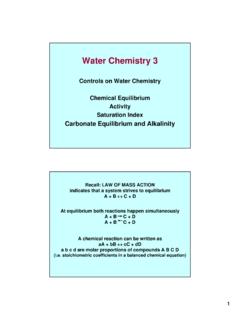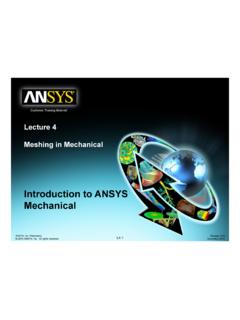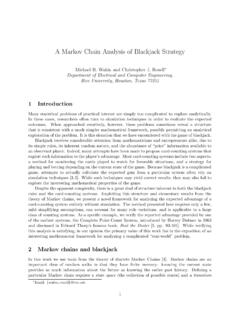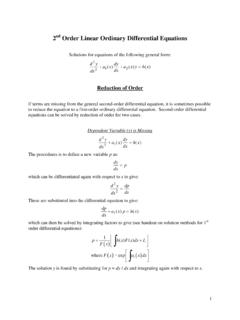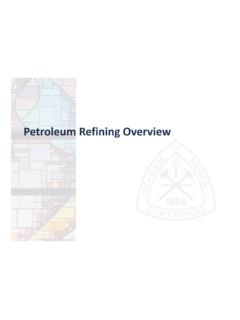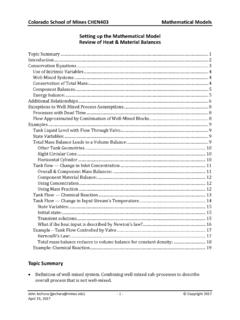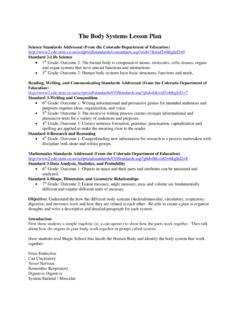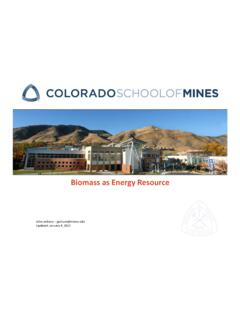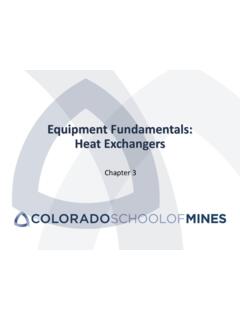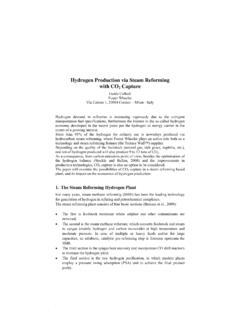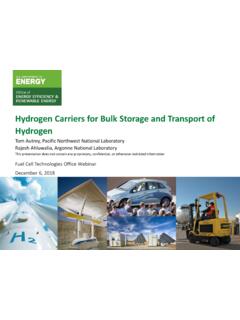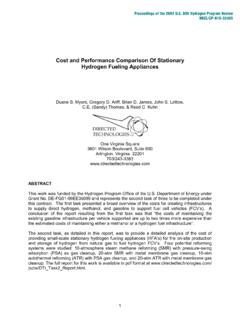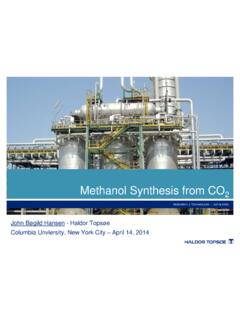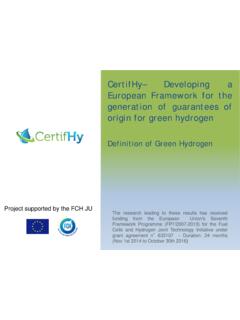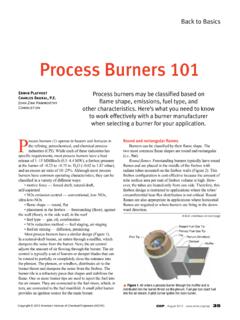Transcription of Hydroprocessing: Hydrotreating& Hydrocracking
1 Hydroprocessing: Hydrotreating& HydrocrackingChapters 7 & 9 Updated: July 12, 2018 Copyright 2017 John Jechura NaphthaCrudeOilDesalterAtmospheric DistillationVacuum DistillationGas Separation & StabilizerSolvent DeasphaltingCokingVisbreakingFluidized Catalytic CrackingHydro-crackingNaphthaReformingIs om-erizationSat Gas PlantPolymer-izationAlkylationNaphthaHyd ro-treatingTreating & BlendingCokeFuel GasLPGA viation GasolineAutomotive GasolineSolventsJet FuelsKeroseneSolventsHeating OilsDieselResidualFuel OilsLubricantGreasesWaxesAsphaltsHeavyNa phthaKeroseneDistillateAGOLVGOHVGOV acuumResiduumCatDistillatesGas Oil Hydro-treatingDAOI somerateGasAlkylFeedAlkylatePolymerizati onNaphthaGasesButanesLPGR eformateNaphthaFuel OilBottomsDistillatesDistillateHydro-tre atingCatNaphthaCycle OilsSDAB ottomsCokerNaphthaHeavyCokerGasOilLight CokerGas OilSulfurPlantSulfurNaphthaFuel OilSolventDewaxingLube
2 OilWaxesUpdated: July 12, 2018 Copyright 2017 John Jechura Refinery Implementation of Hydrotreating3 EIA, Jan. 1, 2018 database, published June 2018 : July 12, 2018 Copyright 2017 John Jechura Refinery Implementation of Hydrocracking4 EIA, Jan. 1, 2018 database, published June 2018 : July 12, 2018 Copyright 2017 John Jechura Remove hetero atoms & saturate carbon carbon bonds Sulfur, nitrogen, oxygen, & metals removed Olefinic& aromatic bonds saturated Minimal cracking Minimal conversion 10% to 20% typical Products suitable for further processing or final blending reforming , catalytic cracking, hydrocrackingHydrocracking Severe form of hydroprocessing Break carbon carbon bonds Drastic reduction of molecular weight Reduce average molecular weight & produce higher yields of fuel products 50%+ conversion Products more appropriate for diesel than gasoline5 : July 12, 2018 Copyright 2017 John Jechura Hydrogen Usage6 Refining Overview Petroleum Processes & Products, by Freeman Self, Ed Ekholm, & Keith Bowers, AIChECD ROM, 2000 Updated.
3 July 12, 2018 Copyright 2017 John Jechura of Petroleum Products7 Refining Overview Petroleum Processes & Products, by Freeman Self, Ed Ekholm, & Keith Bowers, AIChECD ROM, 2000 Hydrocracking : hydrogen addition to minimize coke formationUpdated: July 12, 2018 Copyright 2017 John Jechura of Petroleum Products8 Refining Overview Petroleum Processes & Products, by Freeman Self, Ed Ekholm, & Keith Bowers, AIChECD ROM, 2000 Hydrotreating: just enough conversion to remove undesirable atoms; hydrogen addition for atom removalUpdated: July 12, 2018 Copyright 2017 John Jechura is ubiquitous in refinery & expected to increase Produces higher yields & upgrade the quality of fuelsThe typical refinery runs at a hydrogen deficit As hydroprocessingbecomes more prevalent, this deficit will increase As hydroprocessingprogresses in severity, the hydrogen demands increase dramaticallyDriven by several factors Increased use of hydrodesulfurizationfor low sulfur fuels Heavier & higher sulfur crudes Reduction in demand for heavy fuel oil More complete protection of FCCU catalysts Demand for high quality coke Increased production of diesel9 Updated.
4 July 12, 2018 Copyright 2017 John Jechura of Hydrogen in a RefineryBy product from other processes Catalytic Reformer Most important source of hydrogen for the refiner Continuously regenerated reformer: 90 vol% Semi continuously regenerated reformer: 80 vol% FCCU Offgas 5 vol% hydrogen with methane, ethane & propane Several recovery methods (can be combined)oCryogenicoPressure swing adsorption (PSA)oMembrane separationManufactured steam Methane reforming (SMR) Most common method of manufacturing hydrogen 90 95 vol% typical purity Gasification / Partial Oxidation Produce synthesis gas (syngas) Hydrogen recoveryoPressure swing adsorption (PSA)oMembrane separation More expensive than steam reforming but can use low quality by product streams10 Updated: July 12, 2018 Copyright 2017 John Jechura Desired function Cobalt molybdenum sulfur removal & olefin saturation Nickel molybdenum nitrogen removal & aromatic saturation Reactor configuration Downflowfixed bed temperature to control final sulfur content First bed may guard bed for nickel & vanadium oCheaper catalystsoMost removal of hetereoatoms in subsequent beds Selective catalysts for sulfur removal without olefin saturation Maintaining high octane ratingHydrocracking Crystalline silica alumina base with rare earth metals deposited in the lattice Platinum, palladium, tungsten, and/or nickel Rare earth metals typically mixture of lanthanum, cerium.
5 And other minor quantities Acid function promotes the cracking Feed stock must first be hydrotreated Catalysts deactivate & coke forms even with hydrogen present Hydrocrackers require periodic regeneration of the fixed bed catalyst systems Channeling caused by coke accumulation a major concern Can create hot spots that can lead to temperature runaways Reactor configuration Fixed bed typical for gas oil Hydrocracking Expanded circulating bed or slurry proposed for residhydrocracking11 and fuels/en us/art hydroprocessing catalystsUpdated: July 12, 2018 Copyright 2017 John Jechura Bed Configurations12 Petroleum Refining Speight & B. z mMarcel Dekker, Inc., 2002, pg. 452 Sample packing of catalyst on top of supportsModel prepared by Enterprise ProductsUpdated: July 12, 2018 Copyright 2017 John Jechura NaphthaCrudeOilDesalterAtmospheric DistillationVacuum DistillationGas Separation & StabilizerSolvent DeasphaltingCokingVisbreakingFluidized Catalytic CrackingHydro-crackingNaphthaReformingIs om-erizationSat Gas PlantPolymer-izationAlkylationNaphthaHyd ro-treatingTreating & BlendingCokeFuel GasLPGA viation GasolineAutomotive GasolineSolventsJet FuelsKeroseneSolventsHeating OilsDieselResidualFuel OilsLubricantGreasesWaxesAsphaltsHeavyNa phthaKeroseneDistillateAGOLVGOHVGOV acuumResiduumCatDistillatesGas Oil Hydro-treatingDAOI somerateGasAlkylFeedAlkylatePolymerizati onNaphthaGasesButanesLPGR eformateNaphthaFuel OilBottomsDistillatesDistillateHydro-tre atingCatNaphthaCycle OilsSDAB ottomsCokerNaphthaHeavyCokerGasOilLight CokerGas OilSulfurPlantSulfurNaphthaFuel OilSolventDewaxingLube
6 OilWaxesUpdated: July 12, 2018 Copyright 2017 John Jechura Sulfur converted to hydrogen sulfide (H2S) Added hydrogen breaks carbon sulfur bonds & saturates remaining hydrocarbon chains Form of sulfur bonds Sulfur in naphtha generally mercaptans(thiols) & sulfides In heavier feeds, more sulfur as disulphides& thiophenes Light ends Heavier distillates make more light ends from breaking more complex sulfur moleculesUnsaturated carbon carbon bonds Olefins saturated one hydrogen molecule added for each double bond Olefins prevalent in cracked streams coker or visbreakernaphtha, catalytic cracker cycle oil, catalytic cracker gasoline Aromatic rings hydrogenated to cycloparaffins (naphthenes) Severe operation Hydrogen consumption strong function of complexity of the aromatics prevalent in heavy distillate hydrotreating, gas oil hydrotreating, hydrocrackingSelective catalysts for hydrotreating cat gasoline for sulfur removal but not saturate olefins Maintain high octane ratings14 Updated.
7 July 12, 2018 Copyright 2017 John Jechura & final hydrocarbon products dependent on position of sulfur in moleculeCH3CH2CH2CH2CH2CH2CH2CH2 SH + H2 CH3CH2CH2CH2CH2CH2CH2CH3+ H2S CH3CH2CH2CH2CH2 S CH2CH2CH3+ 2 H2 CH3CH2CH2CH2CH3+ CH3CH2CH3+ H2 SSaturation of molecules possible because of high H2 concentrationsCH3CH2CH2CH=CHCH2CH2CH3 + H2 CH3CH2CH2CH2CH2CH2CH2CH3 Ultra low sulfur levels difficult Complex structures+ 4 H2 CH3CH2CH2CH3 + H2S MercaptanreversionCH3CH2CH2CH2CH2CH2CH=C H2 + H2S CH3CH2CH2CH2CH2CH2CH2CH2 SH15 Updated: July 12, 2018 Copyright 2017 John Jechura EstimatesDifficult to generalize because conversion of feedstock is relatively lowLiquid products generally have volume & gravity increase typically +1oAPIG eneral relationship of hydrogen required vs. sulfur content Naphtha:(scf/bblH2) = 191 (wt% sulfur) Middle distillates: (scf/bblH2) = (wt% sulfur) + (% desulfurized) Refinery Process Economics, 2nded.
8 , Robert E. Maples, 2000 Fundamentals of Petroleum Refining, by Fahim, Al Sahhaf, & Elkilani, Elsevier, 2010 Updated: July 12, 2018 Copyright 2017 John Jechura Process Parameters17 Refining Processes, by James G. Speight & Baki z m, Marcel Dekker, Inc., 2002 Supplemented by personal conversation with Bart CarpenterLHSV = Reactant Liquid Hourly Space Velocity= Liquid volumetric flow volume catalystUpdated: July 12, 2018 Copyright 2017 John Jechura Distribution vs. Boiling Point LCO Feedstock 18 Updated: July 12, 2018 Copyright 2017 John Jechura Effects of Process VariablesReactor inlet temperature & pressure Increasing temperature increases hydrogenation but decreases the number of active catalyst sites Temperature control is used to offset the decline in catalyst activity Increasing pressure increases hydrogen partial pressure & increases the severity of hydrogenationRecycle hydrogen Require high concentration of hydrogen at reactor outlet Hydrogen amount is much more than stoichiometric High concentrations required to prevent coke laydown & poisoning of catalyst Particularly true for the heavier distillates containing resins and asphaltenesPurge hydrogen Removes light ends & helps maintain high hydrogen concentration19 Updated.
9 July 12, 2018 Copyright 2017 John Jechura HydrotreatingNaphtha hydrotreatedprimarily for sulfur removal Mostly mercaptans(R SH) & sulfides (R S R') Some disulfides (R S S R'), & thiophenes(ring structures)Most common catalyst cobalt molybdenum on aluminaChemical hydrogen consumption typically 50 to 250 scf/bbl For desulfurization containing up to 1 wt% sulfur 70 to 100 scf/bbl Significant nitrogen & sulfur removal 250 scf/bblUltra low sulfur levels difficult because of 20 Updated: July 12, 2018 Copyright 2017 John Jechura HydrotreatingProcessReactor typically at 200 psig & 700oF Temperature increases to compensate for decrease in catalyst activityLiquid space velocity ~ 2 per hourHydrogen recycle ~ 2,000 scf/bblAcid gas removal may not be directly incorporated into recycle gas loop Overhead vapor from fractionator to saturates gas plant to recover light hydrocarbons & remove H2 SProduct fractionation Pentane/hexane overhead either to blending or isomerization Bottoms to reformer21 HaldoTops eprocess flow2011 Refining Processes HandbookHydrocarbon Processing, 2011 Updated.
10 July 12, 2018 Copyright 2017 John Jechura HydrotreatingIn general, all liquid distillate streams contain sulfur compounds that must be removedSaturate olefins in diesel to improve the cetanenumberHydrogenation at the high pressure produces small amounts of naphtha from Hydrocracking Required to get at the embedded sulfur Diesel hydrotreaterstabilizer will have an upper sidestreamdraw producing the naphtha which is recycled to motor gasoline processing22 Total Distillate : July 12, 2018 Copyright 2017 John Jechura HydrotreatingProcessReactor typically at 800oFHydrogen recycle starts at 2,000 scf/bbl; consumption 100 to 400 scf/bblConditions highly dependent upon feedstock Distillate (jet fuel & diesel) with 85% 95% sulfur removal 300 psig hydrogen consumption 200 300 scf/bbl Saturation of diesel for cetanenumber improvement over 800 scf/bblhydrogen up to 1,000 psig23 HaldoTops eprocess flow2011 Refining Processes HandbookHydrocarbon Processing, 2011 Updated: July 12, 2018 Copyright 2017 John Jechura Point Ranges for Products24-5001,0001,5002,0002,5003,0000 100200300400500600700800 BPT [ F]Incremental Yield [bpd] ,145 bpd Sour Distillate Feed18,292 bpd Treated DistillateBased on example problem in:Refinery Process Modeling, A Practical Guide to Steady State Modeling of Petroleum Processes, Kaes, Athens Printing Company, 02004 Updated.
